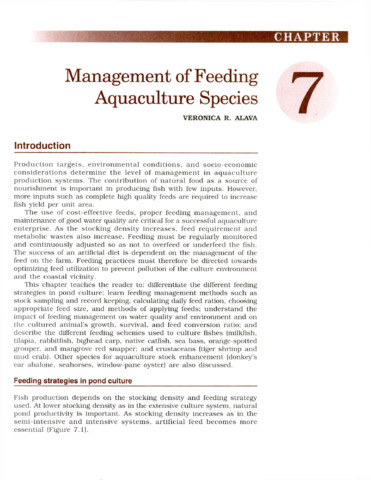Growth and survival of milkfish (Chanos chanos) larvae reared on artificial diets
- Global styles
- MLA
- Vancouver
- Elsevier - Harvard
- APA
- Help

Date
1996Page views
9,098ASFA keyword
AGROVOC keyword
Taxonomic term
Metadata
Show full item record
Share
Abstract
A preliminary feeding experiment was conducted to determine growth and survival of milkfish larvae reared on various feeding regimes involving the use of artificial diets. Two larval diets (Feed A and Feed B) containing 45% protein and 10% lipid were fed either alone or in combination with Brachionus from day 8 to day 21. The feed in the control treatment were Brachionus (10 ind/ml) from day 8 to day 14 and Artemia (2-3 ind/ml) from day 15 to day 21. Larvae in all treatments were fed Brachionus (10 ind/ml) from day 2 to day 7.
No significant differences were observed in survival rates, total length, wet weight and dry weight among fish fed combination of Brachionus and Feed B and the control feed (Brachionus and Artemia). These promising results indicate the possibility of using Feed B as partial replacement or supplement to live food. However, lowest survival rates, total length, and weight were obtained in fish fed either Feed A or Feed B alone, indicating that the test artificial diets given solely to milkfish larvae starting from day 8 can not support good growth and survival. Further studies on the development of improved artificial diets for larval milkfish need to be done.
Suggested Citation
Borlongan, I. G., Marte, C. L., & Nocillado, J. (1996). Growth and survival of milkfish (Chanos chanos) larvae reared on artificial diets. In C. L. Marte, G. F. Quinitio, & A. C. Emata (Eds.), Proceedings of the Seminar-Workshop on Breeding and Seed Production of Cultured Finfishes in the Philippines, Tigbauan, Iloilo, Philippines, 4-5 May 1993 (p. 171). Tigbauan, Iloilo, Philippines: Aquaculture Department, Southeast Asian Fisheries Development Center.
Type
Conference paperISBN
9718511326
Related items
Showing items related by title, author, creator and subject.
-
Management of feeding aquaculture species
Alava, Veronica R. (Aquaculture Department, Southeast Asian Fisheries Development Center, 2002)This chapter teaches the reader to: differentiate the different feeding strategies in pond culture; learn feeding management methods such as stock sampling and record keeping, calculating daily feed ration, choosing ... -
Potential of feed pea (Pisum sativum) meal as a protein source in practical diets for milkfish (Chanos chanos Forsskal)
Borlongan, Ilda G.; Eusebio, Perla S.; Welsh, Tim (Elsevier, 2003)A 12-week feeding trial was conducted to evaluate the use of feed pea meal as a dietary protein source for juvenile milkfish. Six isonitrogenous (30% crude protein) and isocaloric (16.5 kJ/g) practical diets were formulated. ... -
A preliminary study on the purified test diet for young milkfish, Chanos chanos
Lee, Dong-Liang; Liao, I-Chiu (Aquaculture Department, Southeast Asian Fisheries Development Center, 1976)In studying the nutritional requirements of young milkfish experiments were conducted to develop a purified test diet. Mixtures of the purified constituents tested were: vitamin-free casein, vitamin-free gelatin, supplemented ...






